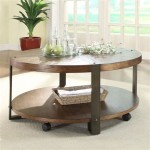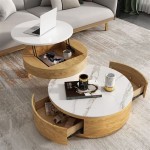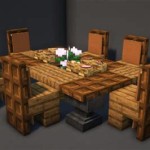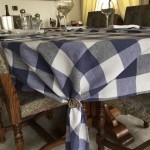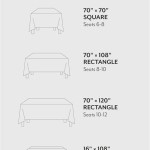How To Make A Photo Table Runner
Creating a photo table runner presents a unique opportunity to personalize home décor and showcase cherished memories. This project is adaptable to various skill levels and budgets, offering a tangible way to display photographs in a functional and aesthetically pleasing manner. This article will guide readers through the process of crafting a photo table runner, outlining the necessary materials, detailed instructions, and helpful tips.
The creation of a photo table runner involves several key components. First, the selection and preparation of photographs is crucial. Secondly, the choice of fabric and stabilizing materials significantly impacts the durability and visual appeal of the finished product. Finally, the assembly process, including cutting, layering, and sewing, requires precision and attention to detail.
Selecting and Preparing Photographs
The initial step in crafting a photo table runner involves selecting the photographs to be featured. Consider the overall theme or occasion for which the table runner is intended. For instance, a family gathering might prompt the use of candid family photos, while a holiday celebration could inspire the use of seasonal imagery. Evaluate the image quality of the chosen photographs. High-resolution images will produce clearer and more visually appealing prints. Low-resolution images may appear pixelated or blurry when enlarged.
Once photographs have been selected, they must be prepared for printing. Digital manipulation may be necessary to optimize the images for the table runner. This may include adjusting brightness, contrast, and color saturation to ensure consistency across all photographs. Cropping images can also be employed to highlight specific subjects or create a more uniform appearance. Photo editing software programs, such as Adobe Photoshop or GIMP, offer a range of tools for these adjustments. Free online photo editing tools are also available for those seeking more accessible options.
The sizing of the photographs is a critical consideration. Determine the desired dimensions of the table runner and plan the arrangement of the photographs accordingly. Consider creating a template to visualize the layout and ensure proper spacing. It is advisable to print test copies of the photographs at various sizes to assess the final appearance before committing to the full production. Photo paper specifically designed for printing photographs is recommended for optimal print quality. Matte or semi-gloss finishes can help reduce glare and fingerprints.
After printing, protect the photographs from damage during the crafting process. Applying a clear sealant spray can provide a protective layer against moisture and scratches. This added precaution will help preserve the longevity of the finished table runner. Allow the sealant to dry completely before proceeding to the next step.
Choosing Fabric and Stabilizing Materials
The selection of fabric for the table runner is fundamental to its overall aesthetic and functionality. Durable, washable fabrics are preferable, as table runners are likely to be subjected to spills and stains. Cotton, linen, and polyester blends are popular choices for their durability and ease of care. Consider the color and pattern of the fabric in relation to the photographs. A neutral background fabric will allow the photographs to stand out, while a patterned fabric can add visual interest to the overall design.
The weight of the fabric should also be considered. A heavier fabric will provide a more substantial feel and help the table runner lay flat. Lightweight fabrics may require additional layers of interfacing to add structure and prevent wrinkling. Interfacing is a fabric-like material that is fused or sewn to the back of the main fabric to provide stiffness and stability. Several types of interfacing are available, including fusible and sew-in options.
In addition to interfacing, consider using batting or wadding between the fabric layers to add cushioning and insulation. This is particularly useful for a table runner intended for use on a delicate surface, such as a polished wood table. Batting is available in various thicknesses and materials, including cotton, polyester, and wool. Choose a batting material that is compatible with the chosen fabric and suitable for the intended use of the table runner.
The selection of thread is another important consideration. Use a high-quality thread that is color-coordinated with the fabric. Polyester thread is a durable and versatile option. Test the thread on a scrap of fabric to ensure that it does not snag or break easily. The type of needle used in the sewing machine should also be appropriate for the fabric being used. A universal needle is suitable for most fabrics, but specialized needles may be necessary for thicker or more delicate materials.
Assembling the Photo Table Runner
The assembly process begins with accurately cutting the fabric and interfacing to the desired dimensions. Use a rotary cutter, ruler, and cutting mat for precise cuts. Add seam allowances to all edges to allow for hemming and joining the fabric layers. The seam allowance should typically be between 1/4 inch and 1/2 inch, depending on the chosen sewing technique.
Next, arrange the photographs on the fabric according to the planned layout. Secure the photographs in place using fabric glue or fusible webbing. If using fabric glue, apply a thin, even layer to the back of each photograph and carefully position it on the fabric. If using fusible webbing, cut the webbing to the same size as the photograph and iron it onto the back of the photograph. Then, peel off the backing paper and iron the photograph onto the fabric. Ensure that the photographs are securely adhered to the fabric before proceeding.
Layer the fabric pieces together, with the right side of the fabric facing up and the interfacing or batting underneath. Pin the layers together to prevent shifting during sewing. Begin sewing around the perimeter of the table runner, leaving an opening for turning the fabric right side out. Use a straight stitch and a consistent seam allowance. Reinforce the corners by backstitching several times.
After sewing, trim the excess fabric and interfacing from the corners to reduce bulk. Turn the table runner right side out through the opening. Use a point turner or a blunt instrument to push out the corners and create sharp, clean edges. Press the table runner with an iron to smooth out any wrinkles and creases. Fold in the edges of the opening and pin them in place. Topstitch around the perimeter of the table runner, closing the opening and adding a decorative finish. Consider adding additional embellishments, such as ribbons, lace, or decorative stitching, to enhance the visual appeal of the table runner.
Once the topstitching is complete, thoroughly inspect the table runner for any loose threads or imperfections. Trim any stray threads and make any necessary repairs. Press the table runner one final time to ensure that it is smooth and wrinkle-free. The photo table runner is now ready for use, providing a personalized and functional addition to home décor.
Maintenance of the photo table runner is essential to preserve its appearance and longevity. Spot clean any spills or stains immediately to prevent them from setting. Hand washing is recommended for delicate fabrics, while machine washing may be suitable for more durable fabrics. Consult the care instructions for the chosen fabric to determine the appropriate washing method. Avoid using harsh chemicals or bleach, as these can damage the fabric and fade the photographs. Tumble dry on low heat or hang to dry. Iron the table runner as needed to remove wrinkles and maintain its pristine appearance.
The photo table runner project offers opportunities for creative customization. Different fabric choices, photograph arrangements, and embellishments can be used to create unique and personalized designs. Consider incorporating fabric paint, embroidery, or other decorative techniques to further enhance the visual appeal of the table runner. The finished photo table runner serves not only as a decorative element but also as a cherished keepsake, showcasing memories in a tangible and functional way.

How To Make A Table Runner 3 Easy Diy Runners Treasurie

How To Make A Reversible Table Runner For Beginners

How To Make A Fabric Table Runner Easy Diy Home Sewing Project

Beginners Table Runner Very Detailed Instructions

How To Make A Table Runner The Easy Way Semigloss Design

How To Make A Farmhouse Table Runner Well Purposed Woman

How To Make Easy Diy Table Runners For Your Next Party Stationers

One Hour Version Of The 10 Minute Table Runner Super Mom No Cape

How To Make An Easy No Sew Fringed Table Runner Oregon Cottage

Tutorial How To Make A Simple Table Runner Sew My Place
Related Posts


